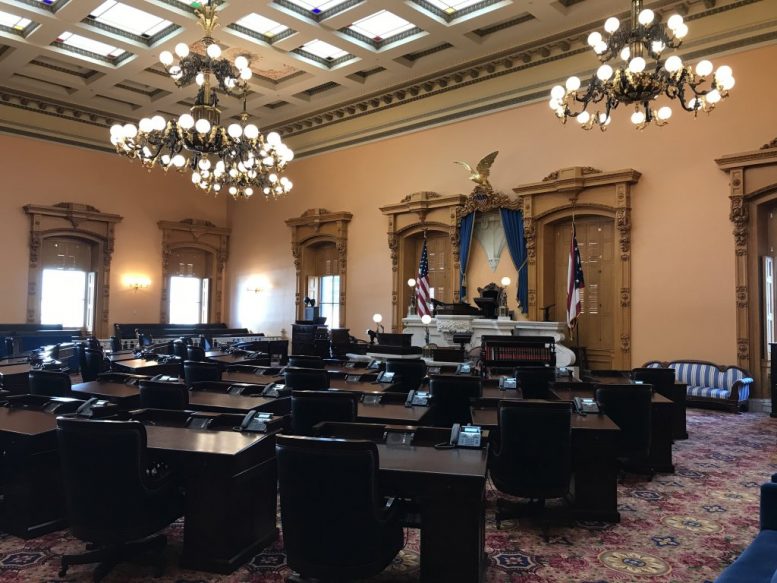By Susan Tebben
A piece of legislation that would reduce the amount of training needed to arm teachers in schools has a long history of similar attempts and varied interpretations of Ohio law.
Senate Bill 317 is currently sitting in the Government Oversight and Reform committee, the chair of which, state Sen. Bill Coley, is the bill’s sponsor. The bill would provide exceptions to current law barring possession of firearms in “school safety zones,” which include school property, school-sponsored activities and buses. Those exceptions would include security officers employed by a board of education, or those with written authorization from the board of education or school district governing body.
The bill comes after the 12th District Court of Appeals disagreed with a lower court that the Madison Local School District, in Coley’s home county of Butler, could pass a resolution allowing district employees to carry concealed firearms into school safety zones. The court ruled that “exceptions for certain school personnel” included in Ohio Revised Code did not allow the district to give authority to personnel without the proper training by the Ohio Peace Officer Training Academy (OPOTA) or without 20 years of active duty as an officer.
“The express language of the statute does not suggest an intention to allow teachers or staff to carry a firearm while on duty with less training than indicated in the statute,” the court stated in their decision.
The court also said if the legislature wanted to reduce the training or experience needed to arm personnel in schools, “it is their legislative prerogative to create such an exception.”
The Buckeye Firearms Association (BFA) supports the legislation, calling the proposed bill “necessary” after the court decision said even volunteers would need the peace officer training.
“This flawed interpretation would require more than 700 hours of training, much of it completely unrelated to the situation the district is trying to address,” said Rob Sexton, legislative affairs director for BFA in testimony supporting SB 317. “Worse, this decision will prevent any school district in Ohio from allowing staff to go armed to save the lives of school children in the event of an active killer situation.”
Sexton said appealing to the Ohio Supreme Court would be costly and time-consuming, so the “better solution…would be for the General Assembly to make the law crystal clear.”
In his testimony to the committee, Sexton didn’t mention the Buckeye Firearms Foundation’s Faculty/Administrator Safety Training & Emergency Response (FASTER) training, that they promote specifically to school districts for teachers, administrators, and other personnel. The program is 26 hours over three days “that exceeds the requirements of the Ohio Peace Officer Training Academy,” according to the website for the program.
The BFA includes in its promotion materials for the FASTER program an interpretation of Ohio law by then-Ohio Attorney General Mike DeWine.
In 2013, DeWine wrote to the chairman of BFA, giving an opinion on whether school boards have the authority to arm administrators, teachers, or other staff. In the letter, he said Ohio law doesn’t prevent districts from arming employees.
“But, if that teacher is required to, in essence, become a security guard as well, the teacher must either have a basic peace officer certification from the Ohio Peace Officer Training Academy (OPOTA) or he or she must have 20 years of experience as a law enforcement officer,” DeWine wrote, citing the same part of Ohio Revised Code the 12th District Court would later cite in the Madison Schools case.
In another part of Ohio law, DeWine interprets language approved by the General Assembly as saying “special police officer, security guard, or other position” means security personnel, and said it was “unlikely that the General Assembly intended this language to reach every school employee.”
So, DeWine writes, the board of education or administration of a school can give non-security personnel written authorization to carry a weapon on school property, but the person “is still subject to the carry and conveyance restrictions under Ohio’s Concealed Carry Laws.”
That point could be up in the air as well, now, because another firearm-related law still up for consideration is House Bill 178, which would allow Ohioans to carry concealed handguns without a permit.
DeWine made further recommendations regarding school safety in 2014, when House Bill 8 was proposed. The bill had similar language to the current Senate bill, authorizing boards of education to designate employees allowed to carry handguns in school zones.
The bill would have also authorized off-duty peace officers to possess deadly weapons in a school zone, and provided immunity to boards of education and governing boards from civil liability if authorized employees caused injury, death, or loss from use of the handgun by employees during school or school functions.
DeWine released a memorandum of recommendations from a working group in 2014 related to the proposed legislation. The memorandum recommended 152 hours of training for school employees, including on topics such as response to school shootings, local planning, crisis intervention, civil liability and use of force training, subject control, building searches, along with 60 hours of handgun training.
House Bill 8 passed the House in 2014, but died in Senate committee.
While the legislature has several supporters of gun rights and the Second Amendment, including several on the committee considering SB 317 who have received campaign donations from the Buckeye Firearms Association, not everyone on that side of the aisle supports seeing guns in schools.
Sen. Peggy Lehner, R-Kettering, stepped out in favor of gun control laws after the 2019 shooting in Dayton’s Oregon district. As chair of the Senate Education Committee, Lehner said she sees no use in legislating more guns into schools.
If anyone is armed in schools, Lehner said, it should be a school resource officer, trained as a police officer is. But there are more important things to focus on when it comes to school safety, she said.
“I think it would be far more beneficial to be spending money on school counselors and school psychiatrists,” Lehner told the Capital Journal. “The needs of kids are such that they need a strong adult that they can lean on for help.”
In a study of 41 nationwide “incidents of targeted school violence” from 2008 to 2017, the United States Secret Service’s National Threat Assessment Center found that of the schools targeted, only seven had “any type of system in place to notify school staff or administrators of threatening or concerning student behaviors before an attack.” Only nine had a program to “assess unwanted or potentially harmful student behavior.”
Of the 41 attacks studied by the Secret Service , only nine were stopped by “non-law enforcement adult school staff,” the threat assessment analysis stated.
A study of “school-associated violent deaths” by the Centers for Disease Control and Prevention found that nearly half of the perpetrators of youth homicide “gave some type of warning signal, such as making a threat or leaving a note, before the event.”
In the 2019-2020 biennium operating budget signed by DeWine, $675 million in wraparound services for schools was approved. The governor’s office said the services would be focused on mental health providers and social service organizations, “to address the social and emotional challenges students face.”
The Senate Committee on Government Oversight and Reform didn’t hold a committee meeting this week, and another hearing on the bill has not been scheduled.




